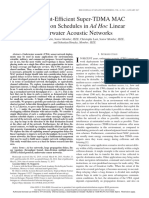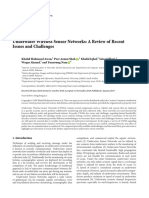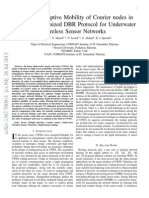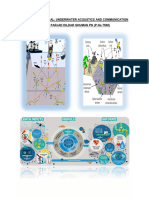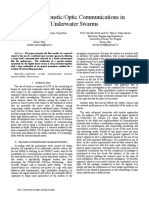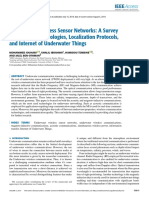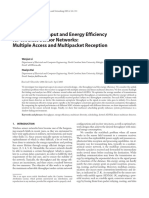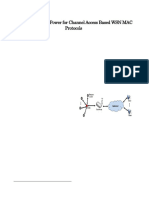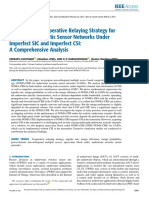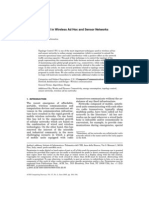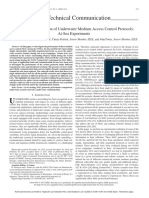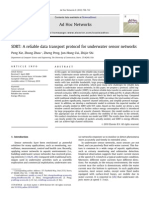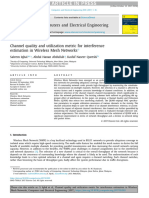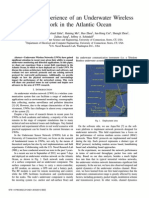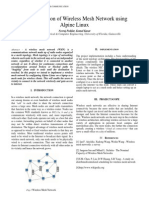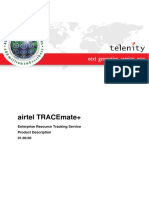UWSN
UWSN
Uploaded by
al shayokhCopyright:
Available Formats
UWSN
UWSN
Uploaded by
al shayokhCopyright
Available Formats
Share this document
Did you find this document useful?
Is this content inappropriate?
Copyright:
Available Formats
UWSN
UWSN
Uploaded by
al shayokhCopyright:
Available Formats
SENSORCOMM 2021 : The Fifteenth International Conference on Sensor Technologies and Applications
Protocols for Underwater Wireless Sensor Networks - Challenges and Solutions
Anne-Lena Kampen
Western Norway University of Applied Sciences
Bergen, Norway
e-mail: alk@hvl.no
Abstract—The underwater environment poses challenges for the protocols should provide solutions that cope with the
communication that can make terrestrial solutions ineffective. dynamic environments and, simultaneously, reduce the
However, the mature terrestrial solutions are based on decades energy consumption of the nodes.
of real-world research and experience, proving their Current underwater wireless solutions are mainly based
sustainability and reliability. Although not suitable for direct on underwater acoustic transmission [2]. The signal
replication, it may be wise to take advantage of these proven propagation for acoustic underwater communication is five
solutions. With this in mind, it is valuable to study successful orders of magnitude slower than light speed; in addition, it is
terrestrial approaches and evaluate their ability to support the
affected by temperature, salinity and depth [3][4]. The low
harsh underwater environment, and to assess how procedures
propagation speed presents a fundamental challenge in
and algorithms can be adapted for efficient underwater
communication. In this paper, we revisit frequently used
coordinating the access to the shared communication
Medium Access Control (MAC) protocols and discuss the medium. The room available for medium access control is
challenges they face in the underwater environment. In compressed, and limited channel capacity should not be used
addition, underwater challenges related to multi-hop data for resource reservation processes requiring large protocol
collection are discussed. To improve reception reliability in the overhead.
highly dynamic underwater environment, we focus on Network layer protocols establish routing paths to enable
broadcast solutions that are constrained to avoid network multihop transmission, which can be used to increase the
flooding. Location-based techniques look very promising in area covered by the network and/ or to reduce the output
this regard. Related to the MAC layer, our recommendation is power, i.e., reduce transmission range, and save energy. The
that underwater communication solutions should focus on routing paths are formed based on specified criteria that aim
preventing collisions at receiver, while reducing the time to support the overall goal for the communication and/or to
between packet reception. support overall network goals. For instance, the data can be
transmitted over several paths simultaneously to support
Keywords-UWSN; underwater wireless sensor networks; reliable communication or the data can be sent alternately
Medium Access Control MAC; underwater routing. over different available paths to balance the energy
consumption in the network to prevent early depletion of
I. INTRODUCTION nodes. However, due to the dynamic characteristic of the
The United Nation (UN) sustainability goal #14, life channel, and potential movement of sensor nodes, it is
below water [1], calls for underwater surveillance solutions difficult to construct proactive routing paths, while reactive
to monitor the marine environment and strengthen ecosystem paths introduce high transmission delay. On the contrary,
knowledge. To this end, sensor networks can be essential broadcasting can limit the delay and reduce the need for
building-blocks in systems used by the ocean industries and proactive configuration. In addition, the reliability is
public surveys for monitoring the seabed and water-column improved because the data are transmitted over several paths.
conditions. The network can contribute to sustainable However, the broadcast should be constrained to reduce
exploitation of underwater resources by monitoring network traffic and limit the energy consumption of the
environmental parameters, and ensure responsible growth nodes. Thus, the peculiar characteristic of the environment
with well-controlled environmental impact. means that protocols used in terrestrial communication
Like terrestrial sensor networks, Medium Access Control require adjustments to provide efficient underwater
(MAC) and network layer protocols are important to build communication. To this end, the contribution of this paper is
sustainable networks. The goal of the MAC is to wisely to discuss characteristics that are challenging when
share the network media between the nodes to provide converting basic terrestrial MAC layer protocols for use in
efficient data collection. The network layer enables data underwater environment. In addition, network layer
from remote nodes to reach its destination. The protocols protocols that enable constrained multicast are investigated.
must adapt to the technology challenges related to the Basic multicast should be avoided to prevent excessive
underwater media, such as low propagation speed, low and network traffic as well and excessive energy consumption.
dynamic channel capacity, interference, ambient noise and The rest of the paper is structured as follows. In Section 2
asymmetric links, and so forth. In addition, the sensors are we present the related work. MAC layer protocols their
mainly battery charged and battery replacement is unfeasible. issues related to the underwater environment are discussed in
Furthermore, the ocean current may move the sensors. Thus, Section 3. Network layer protocols, and their issues, are
Copyright (c) IARIA, 2021. ISBN: 978-1-61208-917-1 34
SENSORCOMM 2021 : The Fifteenth International Conference on Sensor Technologies and Applications
discussed in Section 4. In Section 5 we present the III. MAC PROTOCOLS
conclusion. MAC protocols have a large impact on the overall
II. RELATED WORK network performance because they coordinate the nodes’
access to the medium. The access must be shared fairly
The increasing interest in life and resources below water between the nodes, the scarce bandwidth resource must be
has mobilized a wide range of research on underwater sensor efficient utilized, packet collisions should be avoided, and
networks. The communication protocols are important to the access delay must be limited. In addition, sustainable
enable efficient operation. Thus, a range of solutions are solutions require energy-efficient operations that lengthen
suggested in the literature, and various surveys present and the network lifetime and reduce the management cost. To
discuss selected solutions focusing on various aspects. A this end, the impact for the various states of the
thorough discussion of MAC protocols for underwater communication processes must be investigated to develop
acoustic networks is found in [5]. It is emphasized that the most optimal solution. In addition, dynamic
further studies should focus on methods that handle the long environments and low channel capacity require adaptive and
propagation delay in ways that improve the utilization of the bandwidth-efficient protocols.
available bandwidth. For instance, one way is by allowing The access methods generally used can be categorized as
concurrent transmission as long as packet-collision at the fixed-assignment protocols, demand-assigned protocols and
receiver is prevented. Boukerche and Sun [6] discuss the random-access protocols [12]. In fixed-assignment protocols,
underwater channel modeling, MAC and routing protocols, the channel is divided between the nodes such that nodes can
and localization schemes. It is pointed out that underwater access the medium without any risk of collisions. Typical
environment represents a much more complex environment protocols used are Time Division Mutiple Access (TDMA),
than the hypothesis that the existing approaches are Frequency Division Multiple Access (FDMA) and Code
commonly based upon. The complex environment Division Multiple Access (CDMA). These protocols provide
characteristics are the reason that we, for network layer predictable access delay, and efficient utilization of available
solutions, focus on constrained broadcast rather than single bandwidth. In addition, no energy is wasted on collisions.
path solutions that are more vulnerable for changing channel However, static resource reservation increases the packet
characteristics. loss probability in the highly dynamic underwater
Khisa and Moh [7] focus on energy-efficient routing environment. In addition, the assigned resources require
protocols, and categorize the protocols using a new signaling to renegotiate resources when the network
taxonomy. Energy consumption is also very much in focus topology changes or if nodes require more resources due to
when discussing localization-based and localization-free increased traffic load.
routing protocols, along with routing issues in [8]. In the Demand-assigned protocols provide short term channel
conclusion, Khalid et al. point out that all protocols have assignments. Polling schemes belong to this class of
pros and cons such that a protocol that is best for all cases protocols. The nodes may emit request for channel allocation
cannot be found. The same is pointed out in [9] where and successful allocation is confirmed back to the nodes with
routing protocols for acoustic sensor networks are assessed description of the allocated resources. The resource may be
according to feasible application scenarios. An earlier survey in terms of number and positions of TDMA slots. Time
that gives a nice overview of routing protocols and network slotted communication is illustrated in Figure 1. The
issues is presented in [10]. Terrestrial routing protocols are administration of resources can be distributed to some key-
also compared with Underwater Wireless Sensor Networks nodes in the network, for instance to cluster heads in
(UWSNs) in the survey. The survey presented in [11] clustered networks. However, network-wide resource
focuses on cross-layer designed routing protocols. The reservation is complex as traffic from nodes in adjacent areas
authors define cross layer design as a design where can interfere. In addition, underwater currents or seafloor
algorithms from different layers can exchange information changes may move the nodes. Furthermore, efficient TDMA
with each other, and point out that layered designs are better requires precise synchronization which is challenging in
for creating adaptive solutions. A substantial part of the underwater environments due to the long and variable
protocols suggested for UWSNs do, at least to some degree, transmission delay, however short periods of static and
follow the definition of cross-layer solutions defined in the predictable propagation delay may provide synchronization
paper. For instance, using this definition, all network layer that is accurate enough [13].
protocols that use location or energy level as selection
criteria will be categorized as cross-layer protocols.
Our focus is to present the issues that affect the MAC and
network layer protocols. We review basic MAC layer
algorithms and describe their weakness related to underwater
communication. At the network layer, the focus is on
methods that reduce broadcast. Due to the dynamic
environment, the links are very unreliable. Broadcast
communication is therefore advantageous compared to
communication over pre-decided dedicated links. However, Figure 1. Time slotted communication. TDMA
simple broadcast is a waste of energy.
Copyright (c) IARIA, 2021. ISBN: 978-1-61208-917-1 35
SENSORCOMM 2021 : The Fifteenth International Conference on Sensor Technologies and Applications
The nodes in random-access protocols are uncoordinated backoff. An explicit ACK is sent by the receiver upon
and operate in a fully distributed manner. ALOHA is one of successful reception of the packet. Using slotted CSMA, the
the earliest and most important protocols in this category. In backoff equals a random number of timeslots. Asymmetric
the simplest version of ALOHA, the nodes transmit the links affect the communication efficiency especially when
packets as soon as they are generated. Successfully receiving reliable communication is required. The reason is that when
the packet, the receiver transmits an Acknowledgement ACK messages are lost, the packets will be re-transmitted.
packet (ACK) back to the sender. If the sender does not Re-transmitted packets increase network traffic, which
receive ACK, it assumes that a collision has occurred. It increases collision probability and also the energy
waits a random amount of time (backoff) before consumption.
retransmitting the packet. ALOHA works well when the Furthermore, carrier sense protocols are susceptible to
traffic load is low. Under heavier load the number of hidden node problem and unfair access. The slow
collisions increases, increasing the delay and energy propagation speed can lead to unfair access since there is
consumption, and reducing the throughput efficiency. In special bias in estimating clear channel. Nodes close to the
slotted ALOHA, the time is divided into timeslots, and signal source get a clear channel earlier providing them with
packet transmission can only start at the beginning of a more access opportunities [14]. Another spatial unfairness is
timeslot. The slot time is long enough to accommodate the when nodes closer to the receiver may always win Request
longest allowed packets. Thus, only simultaneously To Send (RTS) contentions since their requests are always
transmitted packets can collide. However, because of the received earliest [15]. The hidden node problem is due to the
long transmission delay, this is not true in underwater distance between the transmitting and receiving node. A
communication. In addition, to avoid collisions, the slot transmitting node, NT1, cannot detect activity at the receiver,
length must also take the transmission time as well as packet Ns, that is caused by a sending node, NT2, whose
length into consideration. That is, the transmission time transmission reaches the receiver, but not the node NT1. To
between the sender and the node that is furthest away, but reduce the hidden-node problem, Request To Send/ Clear To
still within the sender’s transmission range (interference Send (RTS/CTS) can be used. After the sending node has
range), must be considered. obtained channel access it sends a RTS packet to the
Another popular random-access protocol is Carrier Sense receiver. The packet includes a time-field that indicate the
Multiple Access with Collision Avoidance (CSMA/ CA), duration of the overall transaction. Successfully receiving the
which is a random-access scheme with carrier sense and RTS means that there are no hidden nodes that are currently
collision avoidance through random backoff. Different creating interference at the receiver side. The sender replies
backoff algorithms can be used, but they roughly follow the with an CTS, which also includes the duration time-field.
following procedure: To avoid disrupting ongoing Receiving the CTS the transmitter starts transmitting of the
transmissions the nodes listen (carrier sense) to the channel, data packet. Thus, signaling the data transmission with both
and choose a random number of backoff slots within a RTS and CTS, reduced the hidden node problem. In
contention window. After the channel has been idle for a addition, neighbors of both the sender and the receiver are
period equal to Distributed Interface Space (DIFS), the informed about the transmission and its duration. To account
backoff value is decremented for each idle timeslot observed for the long transmission delay in underwater environment,
on the channel. As soon as the counter expires, the node the nodes must delay data transmission according to the
accesses the medium. See illustration in Figure 2, where longest possible delay, and the relatively long time-span
node A transmits a packet after the channel has been idle for increases the probability of transmission from a neighboring
DIFS plus the time it takes for the backoff value to be node. Thus, basic access control processes, such as carrier
counted down. Node B has to wait until the channel has been sense, reservation of the media, and ACK are more time-
idle for DIFS before it starts counting down the backoff consuming and more management is required if these
value. A collision triggers retransmission with a new random processes are to be optimized for neighbors at different
selection of backoff time, and for each collision the distances.
contention window doubles. This is called exponential Channel utilization and the first-in-first-out fairness
police may also suffer from the long delay. The latter is the
case if transmissions arrive out-of-order because the
propagation delay from various senders is unequal. Channel
utilization is reduced because collision-free reception is not
guaranteed although the transmissions from different nodes
are collision-free. Likewise, concurrent transmission may not
lead to collision [16]. To improve the media utilization,
receiver-centric solutions can be used to handle the unequal
delay that exists between the various transmitting nodes.
Receivers can arrange the transmission time for the
Figure 2. Carrier Sense Multiple Access CSMA transmitters so that collisions are avoided, while avoiding
that the time between each received packet is unnecessarily
long, such as suggested in [17]. The major challenge of the
solution is prediction and management of delays, which
Copyright (c) IARIA, 2021. ISBN: 978-1-61208-917-1 36
SENSORCOMM 2021 : The Fifteenth International Conference on Sensor Technologies and Applications
require frequent information exchange between nodes, multichannel protocols is complex, and require advanced
especially under dynamic channel conditions. modems. In addition, if the nodes are equipped with only one
No solution can take all challenges into account. Thus, no transceiver, it means that they can only work one channel at
solutions fit all scenarios as confirmed in the at-sea- a time, either on the control channel or on the data channel.
experiment presented in [18], where the performance of three When this is the case, the handshaking protocols such as
well-known MAC layer protocols, namely CSMA, T-Lohi RTS/CTS must be tuned to prevent triple-hidden terminal
[19][20], and Distance Aware Collision Avoidance Protocol problem [23]. The triple-hidden problem occurs if two of the
(DACAP), is evaluated in an extensive sea-test during nodes in a neighborhood are communicating on a data
NATO at-sea campaigns. CSMA is the simplest of these channel. Simultaneously, another two nodes use the control
protocols, where, to prevent collisions, the nodes listen to channel for handshaking and agree to use channel A for data
detect if the media is idle before transmission. If not idle, the communication. The first two nodes will then be unaware of
nodes back-off according to an exponential back-off the data channel that the last two nodes selected. Thus, if the
mechanism after which it again listens for a silent channel. first two nodes want to initiate a new communication, they
ACK can be used for reliable communication. Applying T- may select data-channel A, creating a collision.
Lohi, the node transmits a reservation-tone, after which it Central one-hop network solutions simplify media access
listens to the channel for the duration of a Contention Round management and general network complexity at the cost of
(CR). If no other tones are heard during CR, the data packet network coverage and network dynamic. Collisions can
is transmitted. Otherwise, it enters back-off state for a easily be avoided using a polling approach where the nodes
random number of CR before repeating the procedure. The are prohibited from transmission unless polled by the central
most advanced of the three protocols is DACAP in which node. The polling sequence is not required to be sequential;
RTS/ CTS is used to reserve the channel. To warn about it can contain repetitions to support nodes with various
possible interference, the destination node sends a short amount of sensor-data [24]. To approach the throughput
warning packet to its sender if it overhears control packets gained using TDMA, [25] suggest a centralized approach.
from other nodes after sending its CTS and before receiving The gateway measures the delay to each individual node to
the associated data packet. If the sender overhears a control organize the nodes’ transmission time and sequence. The
packet, or receives a warning form its destination while gateway manages the network operation such that the data
waiting for CTS, it aborts data communication. Using two from all the nodes are received in strict order, resembling a
different modems, the results reported in [18] for the three subdivision frame. Although interesting approaches, they
different MAC protocols show similar trends, although the require the nodes to stay awake to listen for polling requests.
overall protocol performance is significantly affected by the To summarize, there is no single solution that works best
delays and overheads associated with the acoustic modem in all scenarios, and there is probably a need for solutions
used. Furthermore, the results presented show that different that can be adapted to dynamic changes. Furthermore, most
traffic load, channel conditions and evaluation metric call for of the underwater MAC protocols suggested follow
different solutions. Basically, solutions should be able to terrestrial approach, trying to avoid transmission collision,
adapt, in a distributed way, to dynamically changing although this will not guarantee against collision at reception
conditions. Using DACAP, the network performance is [5]. To efficiently utilize the scarce bandwidth available
deteriorated when the traffic load is increased. ACK packet underwater, the focus should be on the receiver side,
improves packet delivery ratio as long as the link is solutions must reduce the time between packet reception
symmetric, however this is not always the case. CSMA while simultaneously preventing collisions at the receiver.
reduces the transmission attempts since the channel is
reserved by the data packet itself, however, the whole packet IV. NETWORK LAYER PROTOCOLS
has to be retransmitted when collisions occur. The end-to- Multi-hop communication can be used to increase the
end delay of CSMA and DACAP use exponential backoff area covered by the network, or it can be used to reduce the
making the delay increase rapidly with increased number of distance between nodes. The advantage of reducing the
retransmissions. Not using exponential backoff, T-Lohi has distance is that the nodes’ output power can be reduced to
lower end- to- to lay, the price payed is higher packet loss. save energy. Also, the reduced distance can be used to
In contrast to single-channel protocols discussed so far, increase the bit rate by increasing the transmission frequency
multiple-channel protocols rely on several channels for and bandwidth. Furthermore, short distance between nodes
communication to increase network throughput, reduce increases the granularity of the surveyed area which may be
channel access delay, and potentially save energy. valuable to pick up local variations and trends related to the
Neighboring nodes can communicate simultaneously, parameters surveyed. On the other hand, longer distances
provided that they communicate using unequal data between nodes in multi-hop networks can reduce equipment
channels. Furthermore, control signals sent on a different and management costs.
channel will not affect the data that is sent. In [21], the Multihop communication entails challenges such as
control channel is slotted such that each node in a increased network traffic and imbalance in the energy
neighborhood is assigned a unique slot. Thus, also control consumption in the network. Traffic increases because data
packet are prevented from collisions. The solution suggested packets must be forwarded, and management information
in [22] present a quorum-based data channel allocation to must be exchanged to generate and maintain the routing
prevents collisions. However, generation and management of paths. Energy imbalance occurs since the nodes in the
Copyright (c) IARIA, 2021. ISBN: 978-1-61208-917-1 37
SENSORCOMM 2021 : The Fifteenth International Conference on Sensor Technologies and Applications
vicinity of the sink must forward packets for all remote Second, it is likely that the node in the more preferred
located nodes. Furthermore, the harsh underwater location receives the packet later because it is probably
environment makes the generation of routing path more located closer to the sink, and further form the transmitter.
challenging. For instance, it is likely that the quality of a To sum up: wait until the most-preferred node receives the
substantial amount of the links are time varying, thus packet, then wait for the packet relayed by this most-
proactively generated paths may not be reliable. Reactively preferred node to reach the less-preferred nodes. Taking both
created paths, on the other hand, introduce long delay. In of these aspects into consideration increases the delay in the
addition, the links may be unidirectional or asymmetric, network. In addition, when the number of potential successor
which makes it difficult to utilize paths that may be well- nodes is high, a wide range of distinct holding-time-values is
working and stable for communication in the correct required to prevent multiple node timers from expiring
direction. Broadcasting alleviates the challenges related to simultaneously. To provide a broad range of distinct holding-
generating routing paths since all candidate paths are tried, time-values, the average delay in the network increases.
and no specific routing paths needs to be generated. Location-based opportunistic protocols require that nodes
However, the broadcast must be constrained to prevent know their location. GPS is unfeasible as an underwater
excessive network traffic, and to reduce the energy location service. One method of solving the underwater
consumption of the nodes. location problem is to let some dedicated nodes, with known
Opportunistic routing [26] can be an efficient method to locations, send out beacons at regular intervals. Based on
constrain broadcasting. The basic idea is that all receivers received signal, other nodes can use methods like
contend to forward packets, i.e., the senders broadcast the triangulation to determine their own location. Received
packets which are forwarded by the most optimal receiver. power and/ or time delay of acoustic signals offer better
Location-based protocols can be used for opportunistic precision than when using terrestrial radio signals. However,
routing in underwater environments. Using a greedy scheme, some nodes may be located such that they cannot receive the
packets are always forwarded by the node located closest to beacons emitted to estimate locations. To prevent data from
the sink. This is illustrated in Figure 3, where the green node these nodes from being lost, a method such as suggested in
transmits a packet. The circle around the green node [27] can be used: The nodes that do not receive location
illustrates green node’s transmission range. The red node is information use a reactive protocol to send data to the best-
the destination, i.e., the sink. The orange node is the node located neighbor node.
inside the green node’s transmission range that is closest to Routing pipe can be used to reduce the number of
the sink. Thus, the orange node forwards the packet. Only potential forwarding nodes, and reduce the probability of
local information is used to decide whether the received data excessive network traffic for opportunistic protocols. In
should be forwarded, no routing data needs to be exchanged. addition, it alleviates the increased delay needed to
For instance, each data packet contains information about the accommodate the broad range of distinct holding-time-
destination’s location. Nodes that receive the packet start a values discussed above. Assuming a vector from the sender
timer that is proportional to their own distance to the to the target node, the routing pipe is a cylinder with
destination. If the node overhears the packet being forwarded adjustable radius centered around that vector. Nodes inside
by a neighboring node before its own timer reaches zero, it the cylinder are candidate forwarding nodes. The transmitted
refrains from forwarding the packet. Otherwise, it forwards packet carries the position of the sender node, the target
the packet. The long delay in underwater communication node, and the forwarding nodes to enable the receivers to
requires that the timer that sets the holding-time (the time determine whether they are located inside the routing pipe,
between a packet is received until it is potentially forwarded) and whether they are located closer to the destination than
is wisely set. Two aspects must be considered. First, the the transmitting node. This is illustrated in Figure 4. The
timer must be long enough to ensure that a packet forwarded green node transmits a packet toward the sink (the red node).
by a more preferred node is received by the less preferred All nodes within the green circle encircling the green node
node before the timer of the less preferred node expires. are covered by transmission. The packet is forwarded by the
Remember, due to the underwater environment, it takes time
for the forwarded packet to reach the less preferred nodes.
Figure 3. Opportunistic routing. Figure 4. Time slotted communication. TDMA
Copyright (c) IARIA, 2021. ISBN: 978-1-61208-917-1 38
SENSORCOMM 2021 : The Fifteenth International Conference on Sensor Technologies and Applications
orange node since it is the node inside the pipe (blue shaded connected over a unidirectional link, which means that the
cylinder) that is closest to the sink. Adjusting the width of re-emitted packets are a waste of both energy and bandwidth.
the cylinder or the transmission range, adjusts the number of To summarize, due to the dynamically changing channel
candidate forwarders. In [28], to reduce the chances of condition and the long propagation delay in the underwater
forwarding data packets, nodes with less energy than the environment, broadcasting may be a better solution than
transmitting node intentionally calculates a reduced pipe reusing terrestrial routing protocols that generate specific
diameter. Thus, they reduce that chance of being inside the routing paths. Broadcast-based forwarding is likely to
cylinder formed by the sender-receiver vector and diameter. improve the probability of packets reaching their intended
This is done to improve the energy balance in the network. destination. However, the broadcasting procedure should be
A challenge related to location-based routing is the void constrained to reduce both energy consumption and network
region that may exist in the network. To prevent data loss, traffic.
some measures are needed to find detours around the
potential voids. A simple algorithm for finding detours V. CONCLUSION
around voids is to switch to broadcasting when approaching MAC and network layer solutions for underwater
voids regions. Other measures to avoid void generally communication require that characteristics such as long
require that information is exchanged between the nodes. In propagation delay, dynamic channel characteristic and
the depth-based approach suggested in [29], the node limited bandwidth are considered. Long delays are especially
examines its neighbors to check whether they can provide challenging for MAC protocols. The time available for
positive progress toward the destination. If not, the node access control is reduced, and the limited channel resources
requests information from two-hop nodes to adjust its depth should not be depleted by large amount of management
such that positive forwarding can be resumed. To reduce the traffic. For efficient utilization of the limited channel
void problem, and improve the Packet Delivery Ratio (PDR), capacity, the focus should be on the solutions that both
a holding-time that takes several factors into considerations reduce the time between received packets, and, at the same
is suggested in [30]. Firstly, a reliability index is calculated time, prevent packet collisions at the receiver.
based on the energy of the current node and the energy of the Dynamic channel properties make it challenging to
forwarding region. In order to limit formation of energy generate fixed routes. To reduce the probability of packets
holes and thereby increase the reliability, the forwarding being lost during forwarding, we recommend to use
region with the highest energy is selected. Secondly, an constrained broadcasting techniques. Location-based
advancement factor is used: The depth of the note is techniques seem to be especially promising, and should be
calculated so that a small decrease in the depth gives an further investigated.
exponential increase in priority. This reduces the probability In our future work, we will perform extended simulations
of duplicate packet transmissions because the priority of some of the protocols we have discussed in this paper. The
difference is significant, even for a low change in depth. protocols that show promising simulation results will be
Third, a shortest path index is used. It combines the number further evaluated in experimental tests.
of hops toward the destination and the average depth of the
nodes in the next hop. REFERENCES
Other well-known algorithms used in terrestrial Wireless
Sensor Networks (WSNs) to reduce broadcasting, such as [1] D. o. E. a. S. A. United Nations, Sustainable Development.
probabilistic and counter-based schemes may be well-worth "Goal 14." United Nations. https://sdgs.un.org/goals/goal14
testing in underwater environments. Counter-based schemes (retrieved: October 2021.)
are based on the fact that broadcasting a message that has [2] C. M. Gussen et al., "A survey of underwater wireless
already been broadcasted by several neighboring nodes will communication technologies," J. Commun. Inf. Sys, vol. 31,
no. 1, pp. 242-255, 2016.
not give a substantially increase the area covered. Thus, the
nodes are prevented from rebroadcast messages if the [3] S. Gauni et al., "Design and Analysis of Co-operative
Acoustic and Optical Hybrid Communication for Underwater
expected additional coverage is limited. Basically, the nodes Communication," Wireless Personal Communications, vol.
count the number of times a message is received while 117, no. 2, pp. 561-575, 2021.
waiting for medium access. If the counter becomes higher [4] E. Zanaj, E. Gambi, B. Zanaj, D. Disha, and N. Kola,
than a threshold, the transmission is canceled, otherwise the "Underwater wireless sensor networks: Estimation of acoustic
message is transmitted [31][32]. channel in shallow water," Applied Sciences, vol. 10, no. 18,
In probabilistic schemes, the nodes will rebroadcast p. 6393, 2020.
messages with a probability P. If P = 1 the data packets are [5] S. Jiang, "State-of-the-art medium access control (MAC)
protocols for underwater acoustic networks: A survey based
broadcasted. There is a certain probability that no neighbors on a MAC reference model," IEEE communications surveys
choose to forward a packet. To ensure the progress of a & tutorials, vol. 20, no. 1, pp. 96-131, 2017.
packet towards the destination, the sender can re-emit the [6] A. Boukerche and P. Sun, "Design of Algorithms and
packet if no forwarded packets are heard. However, to ensure Protocols for Underwater Acoustic Wireless Sensor
the packet’s progress, the sender may need to re-emit the Networks," ACM Computing Surveys (CSUR), vol. 53, no. 6,
packet several times, which increases network traffic. In pp. 1-34, 2020.
addition, the packet may have been forwarded by nodes [7] S. Khisa and S. Moh, "Survey on Recent Advancements in
Energy-Efficient Routing Protocols for Underwater Wireless
Copyright (c) IARIA, 2021. ISBN: 978-1-61208-917-1 39
SENSORCOMM 2021 : The Fifteenth International Conference on Sensor Technologies and Applications
Sensor Networks," IEEE Access, vol. 9, pp. 55045-55062, networks," IEEE Journal on Selected Areas in
2021. Communications, vol. 26, no. 9, pp. 1731-1743, 2008.
[8] M. Khalid et al., "A survey of routing issues and associated [21] C. Zidi, F. Bouabdallah, R. Boutaba, and A. Mehaoua, "MC-
protocols in underwater wireless sensor networks," Journal of UWMAC: A multi-channel MAC protocol for underwater
Sensors, vol. 2017, 2017. sensor networks," in 2017 International Conference on
[9] Q. Lu and J. Shengming, "A review of routing protocols of Wireless Networks and Mobile Communications (WINCOM),
underwater acoustic sensor networks from application IEEE, pp. 1-6, 2017.
perspective," in 2016 IEEE International Conference on [22] F. Bouabdallah, R. Boutaba, and A. Mehaoua, "Collision
Communication Systems (ICCS), IEEE, pp. 1-6, 2016. avoidance energy efficient multi-channel MAC protocol for
[10] M. Ayaz, I. Baig, A. Abdullah, and I. Faye, "A survey on underwater acoustic sensor networks," IEEE Transactions on
routing techniques in underwater wireless sensor networks," Mobile Computing, vol. 18, no. 10, pp. 2298-2314, 2018.
Journal of Network and Computer Applications, vol. 34, no. [23] Z. Zhou, Z. Peng, J.-H. Cui, and Z. Jiang, "Handling triple
6, pp. 1908-1927, 2011. hidden terminal problems for multichannel MAC in long-
[11] N. Li, J.-F. Martínez, J. M. Meneses Chaus, and M. Eckert, delay underwater sensor networks," IEEE Transactions on
"A survey on underwater acoustic sensor network routing Mobile Computing, vol. 11, no. 1, pp. 139-154, 2011.
protocols," Sensors, vol. 16, no. 3, p. 414, 2016. [24] W. Liu et al., "APOLL: Adaptive polling for reconfigurable
[12] H. Karl and A. Willig, Protocols and architectures for wireless underwater data collection systems," in 2018 OCEANS-
sensor networks. John Wiley & Sons, 2007. MTS/IEEE Kobe Techno-Oceans (OTO), IEEE, pp. 1-9,
2018.
[13] A. A. Syed and J. S. Heidemann, "Time Synchronization for
High Latency Acoustic Networks," in Infocom, vol. 6, pp. 1- [25] N. Morozs, P. Mitchell, and Y. V. Zakharov, "TDA-MAC:
12, 2006. TDMA without clock synchronization in underwater acoustic
networks," IEEE Access, vol. 6, pp. 1091-1108, 2017.
[14] W.-H. Liao and C.-C. Huang, "SF-MAC: A spatially fair
MAC protocol for underwater acoustic sensor networks," [26] V. G. Menon and P. J. Prathap, "Comparative analysis of
IEEE sensors journal, vol. 12, no. 6, pp. 1686-1694, 2011. opportunistic routing protocols for underwater acoustic sensor
networks," in 2016 international conference on emerging
[15] M. A. Hossain, A. Karmaker, and M. S. Alam, "Resolving technological trends (ICETT), IEEE, pp. 1-5, 2016.
spatial unfairness problem with reduced-handshaking in
underwater acoustic sensor network," in 2017 International [27] S. Lee and D. Kim, "Underwater hybrid routing protocol for
Conference on Wireless Communications, Signal Processing UWSNs," in 2013 Fifth International Conference on
and Networking (WiSPNET), IEEE, pp. 2178-2182, 2017. Ubiquitous and Future Networks (ICUFN), IEEE, pp. 472-
475, 2013.
[16] K. Kebkal, A. Mashoshin, and N. Morozs, "Solutions for
underwater communication and positioning network [28] S. M. Mazinani, H. Yousefi, and M. Mirzaie, "A vector-based
development," Gyroscopy and navigation, vol. 10, no. 3, pp. routing protocol in underwater wireless sensor networks,"
161-179, 2019. Wireless Personal Communications, vol. 100, no. 4, pp. 1569-
1583, 2018.
[17] N. Chirdchoo, W.-S. Soh, and K. C. Chua, "RIPT: A receiver-
initiated reservation-based protocol for underwater acoustic [29] R. W. Coutinho, A. Boukerche, L. F. Vieira, and A. A.
networks," IEEE Journal on Selected Areas in Loureiro, "Geographic and opportunistic routing for
Communications, vol. 26, no. 9, pp. 1744-1753, 2008. underwater sensor networks," IEEE Transactions on
Computers, vol. 65, no. 2, pp. 548-561, 2015.
[18] R. Petroccia, C. Petrioli, and J. Potter, "Performance
evaluation of underwater medium access control protocols: [30] M. Ismail et al., "Reliable path selection and opportunistic
At-sea experiments," IEEE Journal of Oceanic Engineering, routing protocol for underwater wireless sensor networks,"
vol. 43, no. 2, pp. 547-556, 2017. IEEE Access, vol. 8, pp. 100346-100364, 2020.
[19] A. A. Syed, W. Ye, and J. Heidemann, "T-Lohi: A new class [31] R. Otnes, P. A. van Walree, H. Buen, and H. Song,
of MAC protocols for underwater acoustic sensor networks," "Underwater acoustic network simulation with lookup tables
in IEEE INFOCOM 2008-The 27th Conference on Computer from physical-layer replay," IEEE Journal of Oceanic
Communications, IEEE, pp. 231-235, 2008. Engineering, vol. 40, no. 4, pp. 822-840, 2015.
[20] A. A. Syed, W. Ye, and J. Heidemann, "Comparison and [32] Y.-C. Tseng, S.-Y. Ni, Y.-S. Chen, and J.-P. Sheu, "The
evaluation of the T-Lohi MAC for underwater acoustic sensor broadcast storm problem in a mobile ad hoc network,"
Wireless networks, vol. 8, no. 2, pp. 153-167, 2002.
Copyright (c) IARIA, 2021. ISBN: 978-1-61208-917-1 40
You might also like
- Shallow Water Acoustic Networks Full ReportDocument26 pagesShallow Water Acoustic Networks Full ReportSimmi JoshiNo ratings yet
- SensorsDocument22 pagesSensorsAtul PandeyNo ratings yet
- An Energy Efficient Multichannel MAC Protocol For Cognitive Radio Ad Hoc NetworksDocument8 pagesAn Energy Efficient Multichannel MAC Protocol For Cognitive Radio Ad Hoc NetworksSatish NaiduNo ratings yet
- Paper IDDocument19 pagesPaper IDHarishNo ratings yet
- An Energy Efficient Routing Algorithm For Underwater Acoustic Sensor NetworksDocument5 pagesAn Energy Efficient Routing Algorithm For Underwater Acoustic Sensor NetworksMuthu Vijay DeepakNo ratings yet
- AEA-QoS 深度学习 逐跳转发 小,密集Document14 pagesAEA-QoS 深度学习 逐跳转发 小,密集张No ratings yet
- Underwater Wireless Sensor Networks A Review of ReDocument20 pagesUnderwater Wireless Sensor Networks A Review of ResekharraoNo ratings yet
- 1307 7009 PDFDocument7 pages1307 7009 PDFlakshmiraniNo ratings yet
- Wireless Communications and Mobile Computing - 2020 - Ghafoor - Cognitive Routing in Software Defined Maritime NetworksDocument15 pagesWireless Communications and Mobile Computing - 2020 - Ghafoor - Cognitive Routing in Software Defined Maritime NetworksHafiza zuneraNo ratings yet
- 5 Congestion 5Document6 pages5 Congestion 5junyedNo ratings yet
- Cooperative Communication Based Protocols For Underwater Wireless Sensors Networks: A ReviewDocument22 pagesCooperative Communication Based Protocols For Underwater Wireless Sensors Networks: A ReviewAltaicaNo ratings yet
- DCC MacDocument8 pagesDCC Macjames payneNo ratings yet
- 8 Research ProposalDocument10 pages8 Research ProposalMohammad ArifNo ratings yet
- Hybrid Acoustic/Optic Communications in Underwater SwarmsDocument9 pagesHybrid Acoustic/Optic Communications in Underwater Swarms283472 ktr.phd.ece.19No ratings yet
- Sensor MacDocument57 pagesSensor MacDr MohammedNo ratings yet
- 1 s2.0 S2590123024010466 MainDocument11 pages1 s2.0 S2590123024010466 MainRohithNo ratings yet
- Performance Evaluation of Acoustic Network For Underwater Autonomous Vehicle in Confined SpacesDocument4 pagesPerformance Evaluation of Acoustic Network For Underwater Autonomous Vehicle in Confined SpacesnandeeshNo ratings yet
- Underwater Wireless Sensor Networks A Survey On Enabling Technologies Localization Protocols and Internet of Underwater ThingsDocument21 pagesUnderwater Wireless Sensor Networks A Survey On Enabling Technologies Localization Protocols and Internet of Underwater Thingssuguna sugunaNo ratings yet
- A Traffic-Aware Fair MAC Protocol For Layered DataDocument24 pagesA Traffic-Aware Fair MAC Protocol For Layered Datasamarc476No ratings yet
- Quantum and Classical Communications On Shared InfrastructureDocument2 pagesQuantum and Classical Communications On Shared InfrastructureShowribabu KantaNo ratings yet
- Globecom 2001Document6 pagesGlobecom 2001SherwinNo ratings yet
- Underwater Optical Wireless CommunicationDocument30 pagesUnderwater Optical Wireless CommunicationPhuc HoangNo ratings yet
- WCN 2005 541Document13 pagesWCN 2005 541Choudhury Prasanjit NandaNo ratings yet
- UWB Mengali ChannelEstimationDocument9 pagesUWB Mengali ChannelEstimationJamil AhmadNo ratings yet
- 20180708_WSN_MACDocument10 pages20180708_WSN_MACnyjo.yvesNo ratings yet
- Design Energy Efficient SMAC Protocol For Wireless Sensor Networks Using Neighbour Discovery Scheduling AlgorithmDocument8 pagesDesign Energy Efficient SMAC Protocol For Wireless Sensor Networks Using Neighbour Discovery Scheduling AlgorithmEditor IJTSRDNo ratings yet
- NOMA Based Cooperative Relaying Strategy For Underwater Acoustic Sensor Networks Under Imperfect SIC and Imperfect CSI: A Comprehensive AnalysisDocument16 pagesNOMA Based Cooperative Relaying Strategy For Underwater Acoustic Sensor Networks Under Imperfect SIC and Imperfect CSI: A Comprehensive AnalysisProjects MNo ratings yet
- Le 2008Document10 pagesLe 2008dhrubodebnath98No ratings yet
- Topology Control in Wireless Ad Hoc and Sensor Networks: Istituto Di Informatica e TelematicaDocument31 pagesTopology Control in Wireless Ad Hoc and Sensor Networks: Istituto Di Informatica e TelematicaahlamSUPCOMNo ratings yet
- Power Control and Channel Allocation in Cognitive Radio Networks With Primary Users' CooperationDocument13 pagesPower Control and Channel Allocation in Cognitive Radio Networks With Primary Users' CooperationieeexploreprojectsNo ratings yet
- Literature SurveyDocument10 pagesLiterature SurveynavdeepNo ratings yet
- Performance Evaluation of Underwater Medium Access Control Protocols At-Sea ExperimentsDocument10 pagesPerformance Evaluation of Underwater Medium Access Control Protocols At-Sea Experimentsal shayokhNo ratings yet
- Versatile Low Power Media Access For Wireless Sensor NetworksDocument13 pagesVersatile Low Power Media Access For Wireless Sensor NetworksHarsha KuntamukkalaNo ratings yet
- Underwater Wireless Sensor Networks: Applications, Challenges and Design Issues of The Network LayerDocument7 pagesUnderwater Wireless Sensor Networks: Applications, Challenges and Design Issues of The Network LayerWARSE JournalsNo ratings yet
- SDH Tda Ucomms2018 GSPPDocument6 pagesSDH Tda Ucomms2018 GSPPasim bhattiNo ratings yet
- Intelligent Efficient Routing and Localization in The Underwater Wireless Sensor Network To Improve Network LifetimeDocument21 pagesIntelligent Efficient Routing and Localization in The Underwater Wireless Sensor Network To Improve Network Lifetimeijcncjournal019No ratings yet
- An Energy-Efficient MAC Protocol For Wireless Sensor NetworksDocument10 pagesAn Energy-Efficient MAC Protocol For Wireless Sensor NetworksMandeep SinghNo ratings yet
- 04-3 SDRT A Reliable Data Transport Protocol For Underwater Sensor Networks (2010)Document15 pages04-3 SDRT A Reliable Data Transport Protocol For Underwater Sensor Networks (2010)piranhapressNo ratings yet
- Andrea Fumagalli PaperDocument12 pagesAndrea Fumagalli PaperHuzaifaZafarNo ratings yet
- Paper 2Document12 pagesPaper 2averma3be21No ratings yet
- Iqbal 2017Document16 pagesIqbal 2017Tariq SaeedNo ratings yet
- Field Test Experience of An Underwater Wireless Network in The Atlantic OceanDocument10 pagesField Test Experience of An Underwater Wireless Network in The Atlantic OceansvahidsNo ratings yet
- A New MAC Protocol Design For Long-Term Applications in Wireless Sensor NetworksDocument8 pagesA New MAC Protocol Design For Long-Term Applications in Wireless Sensor NetworksRamalingNo ratings yet
- Future Generation Computer Systems: Anil Carie Mingchu Li Chang Liu Prakasha Reddy Waseef JamalDocument8 pagesFuture Generation Computer Systems: Anil Carie Mingchu Li Chang Liu Prakasha Reddy Waseef Jamalvenkata rao RampayNo ratings yet
- A Tutorial On Cross-Layer OptimizationDocument12 pagesA Tutorial On Cross-Layer OptimizationSana JamilNo ratings yet
- Comparing Energy-Saving MAC Protocols For Wireless Sensor NetworksDocument9 pagesComparing Energy-Saving MAC Protocols For Wireless Sensor NetworksamgedNo ratings yet
- Eri Mac An Energy Harvested Receiver Initiated Mac Protocol For Wireless Sensor NetworksDocument8 pagesEri Mac An Energy Harvested Receiver Initiated Mac Protocol For Wireless Sensor NetworksK AkshayNo ratings yet
- A Comparative Study of MAC Protocols For Linear - 2015 - Procedia Computer ScieDocument8 pagesA Comparative Study of MAC Protocols For Linear - 2015 - Procedia Computer Sciechristiandecir.jcNo ratings yet
- Ultra-Spectra Communication System (USCS) : A Promising Way To Energy-Efficient Green Communication NetworksDocument17 pagesUltra-Spectra Communication System (USCS) : A Promising Way To Energy-Efficient Green Communication NetworksJames DanielNo ratings yet
- Ijctt V3i1p132Document4 pagesIjctt V3i1p132surendiran123No ratings yet
- Research PaperDocument10 pagesResearch PaperShainu SuhasNo ratings yet
- Comparative AnalysisDocument25 pagesComparative AnalysisHamada HamdaNo ratings yet
- Resolving The Fairness Issues in Bus-Based Optical Access NetworksDocument14 pagesResolving The Fairness Issues in Bus-Based Optical Access NetworksMartin ValkoNo ratings yet
- jcp0812 39Document7 pagesjcp0812 39Vmx11No ratings yet
- Merging Ultra-Low Duty Cycle NetworksDocument12 pagesMerging Ultra-Low Duty Cycle Networksmaarten_van_steenNo ratings yet
- Congestion-Less Energy Aware Token Based MAC Protocol Integrated With Sleep Scheduling For Wireless Sensor NetworksDocument6 pagesCongestion-Less Energy Aware Token Based MAC Protocol Integrated With Sleep Scheduling For Wireless Sensor NetworksPintu KumarNo ratings yet
- MAC ProtocolDocument37 pagesMAC Protocolbackaman6377No ratings yet
- Optimization of A Data Link Protocol For An Underwater Acoustic ChannelDocument6 pagesOptimization of A Data Link Protocol For An Underwater Acoustic ChannelDeepak Singh YadavNo ratings yet
- Full-Duplex Communications for Future Wireless NetworksFrom EverandFull-Duplex Communications for Future Wireless NetworksHirley AlvesNo ratings yet
- Signal Integrity: From High-Speed to Radiofrequency ApplicationsFrom EverandSignal Integrity: From High-Speed to Radiofrequency ApplicationsNo ratings yet
- Cisco IOS H.323 Configuration GuideDocument278 pagesCisco IOS H.323 Configuration GuideTran Minh QuocNo ratings yet
- Nokia 7.2: User GuideDocument57 pagesNokia 7.2: User Guideit4728No ratings yet
- Project Proposal Eel 5718 - Computer CommunicationDocument1 pageProject Proposal Eel 5718 - Computer CommunicationnrjpoddarNo ratings yet
- Squid Load Between Two ServersDocument5 pagesSquid Load Between Two ServersMiriel Martin MesaNo ratings yet
- Basic Principle of SGSN PoolDocument2 pagesBasic Principle of SGSN PoolBala Murugan VNo ratings yet
- K01 000 12Document464 pagesK01 000 12arfeemNo ratings yet
- Dell Optiplex GX620Document144 pagesDell Optiplex GX620Jake ElwoodNo ratings yet
- A Flexible Printed Millimetre-Wave Beamforming Network For Wigig and 5G Wireless SubsystemsDocument5 pagesA Flexible Printed Millimetre-Wave Beamforming Network For Wigig and 5G Wireless SubsystemsKatherine Gabriella Hernandez GomezNo ratings yet
- MalaysiaDocument46 pagesMalaysiaPriya DarshiniNo ratings yet
- Service Description: Data Center Optimization ServicesDocument30 pagesService Description: Data Center Optimization ServicesGhallab AlsadehNo ratings yet
- PAL 300x: Operation ManualDocument40 pagesPAL 300x: Operation ManualEveraldo OliveiraNo ratings yet
- D-EOMOC001 (21) 09-15EN Bacnet ItalyDocument119 pagesD-EOMOC001 (21) 09-15EN Bacnet ItalyGustavo CorreiaNo ratings yet
- 750-342 Hawk 4000Document128 pages750-342 Hawk 4000Pablo SánchezNo ratings yet
- 27.1.5 Lab - Convert Data Into A Universal FormatDocument11 pages27.1.5 Lab - Convert Data Into A Universal FormatLISS MADELEN TRAVEZ ANGUETANo ratings yet
- Lab Manual: Electrical Engineering - IECS UST BannuDocument70 pagesLab Manual: Electrical Engineering - IECS UST BannuMuhammad DaudNo ratings yet
- Michigan State Police Social Media PolicyDocument18 pagesMichigan State Police Social Media PolicyFergus BurnsNo ratings yet
- Apollo Opt9608 Delivers Data Center Centric ConnectivityDocument6 pagesApollo Opt9608 Delivers Data Center Centric ConnectivitymexybabyNo ratings yet
- The OSI Model and The TCP/IP Protocol SuiteDocument39 pagesThe OSI Model and The TCP/IP Protocol SuiteS JNo ratings yet
- AIRNET 54Mb 2.4GHz Bridge PTP Kit Quick Configuration GuideDocument15 pagesAIRNET 54Mb 2.4GHz Bridge PTP Kit Quick Configuration GuideAngel Bernardo Gomez LizanaNo ratings yet
- Airtel Tracemateplus Product Description 01.00.00Document46 pagesAirtel Tracemateplus Product Description 01.00.00Arun Kumar100% (1)
- Smartplant License Manager: Installation & Configuration ChecklistDocument9 pagesSmartplant License Manager: Installation & Configuration ChecklistKriztopher UrrutiaNo ratings yet
- BMIS300 Revision Sheet - Final - Fall 2023-2024Document11 pagesBMIS300 Revision Sheet - Final - Fall 2023-2024bilalhijaz73No ratings yet
- Finals Activity 1 - 6.4.3.3 Packet Tracer - Connect A Router To A LANDocument5 pagesFinals Activity 1 - 6.4.3.3 Packet Tracer - Connect A Router To A LANjaxmain1750No ratings yet
- H31 341 Enu V10.02Document40 pagesH31 341 Enu V10.02Abderrahmene LAHBAKNo ratings yet
- Cloud Computing - Assignment 1 - Greenwich FPTDocument38 pagesCloud Computing - Assignment 1 - Greenwich FPTQuách Công TuấnNo ratings yet
- UT Dallas Syllabus For cs6390.001 05f Taught by Kamil Sarac (kxs028100)Document2 pagesUT Dallas Syllabus For cs6390.001 05f Taught by Kamil Sarac (kxs028100)UT Dallas Provost's Technology GroupNo ratings yet
- Cisco 1710 Security Router Software Configuration Guide: Corporate HeadquartersDocument88 pagesCisco 1710 Security Router Software Configuration Guide: Corporate HeadquartersCreaciones JimcNo ratings yet
- HR Orientation Presentation 2020Document38 pagesHR Orientation Presentation 2020mumenalmadainehNo ratings yet
- BLIE 229 - Guess PaperDocument20 pagesBLIE 229 - Guess PaperSmart AijazNo ratings yet
- Radio Repurposed Reaping The Benefits of RF TechnologyDocument13 pagesRadio Repurposed Reaping The Benefits of RF Technologybring it onNo ratings yet



